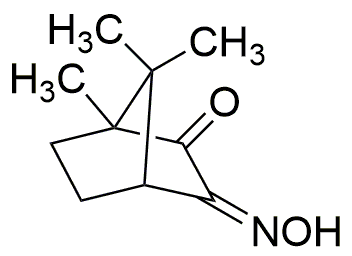anti-(1R)-(+)-Camphorquinone 3-oxime is widely utilized in research focused on:
- Organic Synthesis: This compound serves as a versatile intermediate in the synthesis of various organic molecules, particularly in the creation of complex natural products and pharmaceuticals.
- Photochemical Applications: It is used in photochemical reactions, where its unique structure allows for the generation of reactive intermediates, enhancing the efficiency of light-driven processes.
- Analytical Chemistry: The compound is employed as a reagent in analytical methods, helping to identify and quantify other substances in complex mixtures, which is crucial in quality control in laboratories.
- Material Science: It finds applications in the development of advanced materials, including polymers and coatings, where its properties can improve durability and performance.
- Medicinal Chemistry: Researchers utilize this compound in drug discovery, particularly in the design of new therapeutic agents that target specific biological pathways, offering potential advantages over existing treatments.
General Information
Properties
Safety and Regulations
Applications
anti-(1R)-(+)-Camphorquinone 3-oxime is widely utilized in research focused on:
- Organic Synthesis: This compound serves as a versatile intermediate in the synthesis of various organic molecules, particularly in the creation of complex natural products and pharmaceuticals.
- Photochemical Applications: It is used in photochemical reactions, where its unique structure allows for the generation of reactive intermediates, enhancing the efficiency of light-driven processes.
- Analytical Chemistry: The compound is employed as a reagent in analytical methods, helping to identify and quantify other substances in complex mixtures, which is crucial in quality control in laboratories.
- Material Science: It finds applications in the development of advanced materials, including polymers and coatings, where its properties can improve durability and performance.
- Medicinal Chemistry: Researchers utilize this compound in drug discovery, particularly in the design of new therapeutic agents that target specific biological pathways, offering potential advantages over existing treatments.
Documents
Safety Data Sheets (SDS)
The SDS provides comprehensive safety information on handling, storage, and disposal of the product.
Product Specification (PS)
The PS provides a comprehensive breakdown of the product’s properties, including chemical composition, physical state, purity, and storage requirements. It also details acceptable quality ranges and the product's intended applications.
Certificates of Analysis (COA)
Search for Certificates of Analysis (COA) by entering the products Lot Number. Lot and Batch Numbers can be found on a product’s label following the words ‘Lot’ or ‘Batch’.
*Catalog Number
*Lot Number
Certificates Of Origin (COO)
This COO confirms the country where the product was manufactured, and also details the materials and components used in it and whether it is derived from natural, synthetic, or other specific sources. This certificate may be required for customs, trade, and regulatory compliance.
*Catalog Number
*Lot Number
Safety Data Sheets (SDS)
The SDS provides comprehensive safety information on handling, storage, and disposal of the product.
DownloadProduct Specification (PS)
The PS provides a comprehensive breakdown of the product’s properties, including chemical composition, physical state, purity, and storage requirements. It also details acceptable quality ranges and the product's intended applications.
DownloadCertificates of Analysis (COA)
Search for Certificates of Analysis (COA) by entering the products Lot Number. Lot and Batch Numbers can be found on a product’s label following the words ‘Lot’ or ‘Batch’.
*Catalog Number
*Lot Number
Certificates Of Origin (COO)
This COO confirms the country where the product was manufactured, and also details the materials and components used in it and whether it is derived from natural, synthetic, or other specific sources. This certificate may be required for customs, trade, and regulatory compliance.


